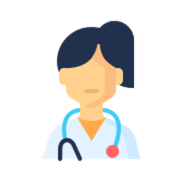
Powered By





 Continue with Facebook
Sign up with your email
Continue with Facebook
Sign up with your email
We’ve all been there: You find a painful bump on your skin and wonder what it could be. Is it a pimple? A boil? Or something else entirely? While pimples and boils are common skin concerns, what you think is a boil could actually be something more complex, like hidradenitis suppurativa (HS).
HS is a chronic condition that causes painful, recurring lumps in areas like the armpits, groin, or under the breasts. It’s often misdiagnosed as boils or severe types of acne, such as acne conglobata. This incorrect diagnosis can leave people without the treatment they need.
In this article, you’ll discover the key differences between boils and pimples — including their causes, symptoms, and treatments — while also learning how to recognize when those bumps might actually be HS. If you’re dealing with recurring skin problems, this guide will allow you to understand what’s happening and encourage you to talk to a dermatologist about your concerns.
Understanding what causes boils, pimples, and HS is the first step to figuring out what’s going on with your skin. Although they may look similar at first glance, these bumps come from very different sources.
Pimples are small growths on the skin and a common feature of acne. There are many types of pimples, some of which may be inflamed or discolored. Types of pimples include papules, pustules, whiteheads, blackheads, nodules, and cysts.
Pimples often result from clogged hair follicles. When excess sebum (oil) mixes with dead skin cells, it can block the pores. In some cases, pimples develop when the body produces too much of a protein called keratin, which contributes to the formation of hair, skin, and nails. Excess bacteria on the skin, such as Cutibacterium acnes, can also cause inflammation and lead to pimples. If most of the people in your family have acne, there is an increased chance that you might have it too.
Risk factors for developing pimples include:
Boils are the result of a bacterial infection, typically caused by Staphylococcus aureus or fungi. The bacteria enter the skin through a cut, scratch, or hair follicle and cause a deep infection. Also called furuncles, boils grow larger and more painful as pus builds up inside. They can sometimes cluster together into a carbuncle.
Risk factors for developing boils include:
Healthcare professionals believe HS lesions may be caused by chronic inflammation and immune system dysregulation, not infection, clogged pores, or excess oil. Hair follicles become blocked, leading to painful, recurring lumps under the skin. Hormonal changes and smoking are known triggers, but HS is not contagious or caused by poor hygiene. However, the chances of having a bacterial infection are high in people with hidradenitis suppurativa.
While pimples, boils, and HS lesions can all appear as discolored, swollen bumps on the skin, their size, shape, and location often reveal what’s behind them.
Pimples are typically small bumps that can be red, white, yellowish, or black, depending on the type. They might start as blackheads or whiteheads but can progress into inflamed pustules or deep, painful cysts in severe cases. Pimples can sometimes be runny if they rupture or are squeezed. Pustules and cystic acne contain pus, which can leak if the lesion breaks open. Inflammatory acne may also release a mixture of pus, oil, or blood, especially if irritated. However, noninflamed pimples like blackheads and whiteheads don’t typically have any fluid drainage.
Pimples can feel tender, sore, or irritated, especially if they’re inflamed. Papules may feel firm and sensitive, while pustules contain pus and can be painful to the touch. More severe acne lesions, such as nodules or cysts, are deeper under the skin and can feel hard, swollen, and very painful.
Boils are larger, more painful lumps that can grow over a span of hours or days as pus builds up inside. They’re red or purplish and swollen, and they often develop a yellow or white “head” as they near draining. Some boils may ooze pus, a sign of the body fighting an infection. Unlike pimples, boils tend to be firm, warm, and extremely tender. They can become squishy as they fill with pus. Their size can range from smaller than a pea to as large as a golf ball, and they’re usually more deeply embedded in the skin than pimples.
Boils are more common in individuals with diabetes, and they may be associated with systemic symptoms such as fever. If you experience these symptoms, you should immediately seek medical attention.
As with pimples, it’s possible to develop just one boil. However, some people develop carbuncles, which are clusters of connected boils caused by a deeper bacterial infection. Carbuncles are larger, more painful, and more likely to cause swelling, pus drainage, and scarring.
By comparison, HS lesions can vary widely in appearance. They often start as tender lumps under the skin that may be mistaken for boils, but they don’t always form a visible head. Over time, they can rupture, drain fluid, or develop into tunnels (also called sinus tracts) that connect under the skin and heal with scarring.
HS lesions are typically firm, swollen, and painful, with discomfort that can range from slight tenderness to deep, intense aching. Some may also burn, itch, or feel warm, particularly during flare-ups. As sinus tracts develop, the skin in affected areas may become lumpy, hardened, or ropelike due to scarring. Unlike boils, HS lesions frequently recur in the same spots and may progressively worsen without proper treatment.
The location of a bump on your body can offer clues about whether it’s a pimple, a boil, or an HS lesion. Each condition has its own pattern of appearance.
Pimples most often form where oil glands are most active — usually the face but also the chest, shoulders, and upper back. These areas are prone to clogged pores due to excess oil and dead skin cells. Pimples can also show up on the jawline, especially if you are experiencing hormonal changes.
Boils can appear almost anywhere on the body but are more common in areas prone to friction, sweating, or hair growth, such as the thighs, buttocks, armpits, neck, or face. If the bacteria spread, boils may cluster in one area and form a carbuncle, leading to a severe infection.
HS lesions typically develop in skin folds where sweat glands are located, such as the neck, armpits, groin, waist, under the breasts, and inner thighs. They can also appear in other friction-prone areas, such as the buttocks or near the anus. Unlike pimples or boils, HS lesions tend to return in the same spots and worsen over time.
Treatment for pimples, boils, and HS differs significantly because each condition has a unique cause. Understanding the right approach is key to finding relief and preventing complications.
Treatment for pimples can vary, depending on the type you have. Often, they can be treated with over-the-counter products containing benzoyl peroxide, salicylic acid, or retinoids, which help unclog pores and reduce bacteria. For moderate to severe acne, a dermatologist might prescribe topical or oral antibiotics, hormonal therapies (like birth control pills), or isotretinoin, a powerful medication for resistant cases. Lifestyle changes, such as adopting a gentle skin care routine and avoiding oily skin care products that are water-based or gel-based, can also help.
Dermatologists recommend against popping pimples at home, as it can lead to scarring, infection, or worse acne.
Boils often improve with simple home care, like applying warm compresses to help drain pus and reduce pain. In some cases, a doctor may need to drain the boil with a small incision or prescribe oral antibiotics to treat the infection. To prevent further boils, keep the skin clean and avoid shaving or friction in sensitive areas. Never squeeze or pop a boil, as this can spread the infection.
The best treatment option for you will depend on several factors, including the severity of your HS symptoms and your general health and medical history. Mild cases might respond to topical treatments like antibiotics or antiseptic washes, while more severe cases often need oral antibiotics, hormonal therapies, or biologics. Surgery may be necessary to remove tunnels or scarring in advanced stages.
Knowing when to seek medical advice can make a big difference in managing skin issues like pimples, boils, and HS. While some bumps clear up on their own, others may need a professional evaluation.
Pimples typically don’t require medical attention unless they’re severe or persistent. If over-the-counter treatments aren’t helping, or if you’re dealing with painful cystic acne, it may be time to see a dermatologist. Severe acne can lead to scarring if left untreated, so early intervention is key. Cleveland Clinic recommends seeing a doctor if you develop many pimples all at one time or if you have especially large, painful, or discolored pimples.
Boils typically clear up in two to three weeks and don’t cause long-term health issues. However, it may be best to speak with your doctor if a boil:
Additionally, repeated boils might signal an underlying condition, such as a weakened immune system, and should be evaluated by a healthcare provider.
HS lesions may prompt a visit to a dermatologist — or in some cases, even to the hospital. Reasons to see a healthcare provider about HS include experiencing intense pain or developing a potential infection. Symptoms such as fever, signs of infection like visible pus or open wounds, and warm skin may all be cause to contact a doctor or visit the emergency room. You may also notice early or easy-to-miss symptoms of HS that warrant a visit with your doctor.
Many skin conditions can look alike, making it difficult to tell whether a bump is a simple pimple, an infected boil, or something more complex like hidradenitis suppurativa. To complicate matters further, it’s possible to have more than one skin condition at the same time, meaning you might experience acne alongside recurring boils or HS lesions.
If you have odd or worrying signs and symptoms, such as painful, swollen, or persistent lumps, it’s important to seek medical advice. A dermatologist can help determine what’s causing your skin issues and recommend the right treatment to relieve symptoms and prevent complications. Early diagnosis is key, so if you’re unsure about what’s happening with your skin, don’t hesitate to reach out to a healthcare provider. A dermatologist is fully trained on how to differentiate between lesions, and they can offer guidance on the best treatment for your specific case.
On myHSteam — the social network for people living with hidradenitis suppurativa — more than 46,000 members come together to ask questions, share experiences, and support one another in managing their skin health.
Have you ever mistaken an HS flare for a boil, severe acne, or other skin condition? How did you realize it was something more? Share your story in the comments below, or start a conversation by posting on your Activities page.
Get updates directly to your inbox.



 Continue with Facebook
Sign up with your email
Continue with Facebook
Sign up with your email
Become a member to get even more




We'd love to hear from you! Please share your name and email to post and read comments.
You'll also get the latest articles directly to your inbox.